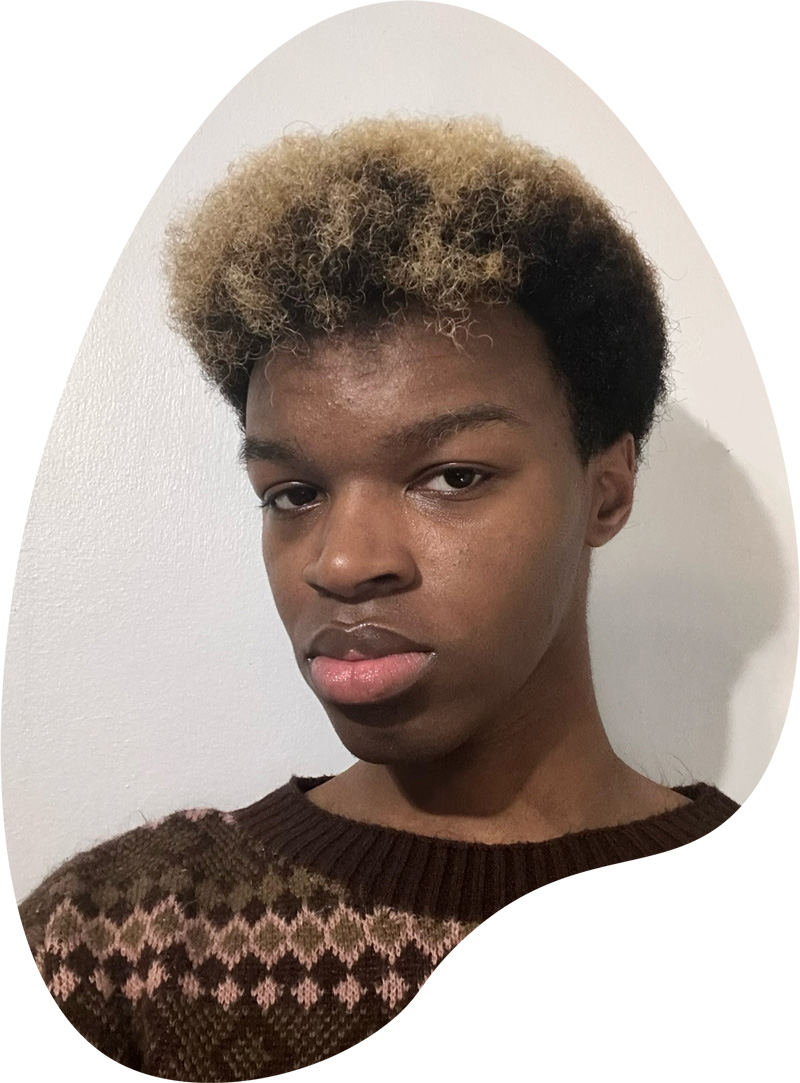
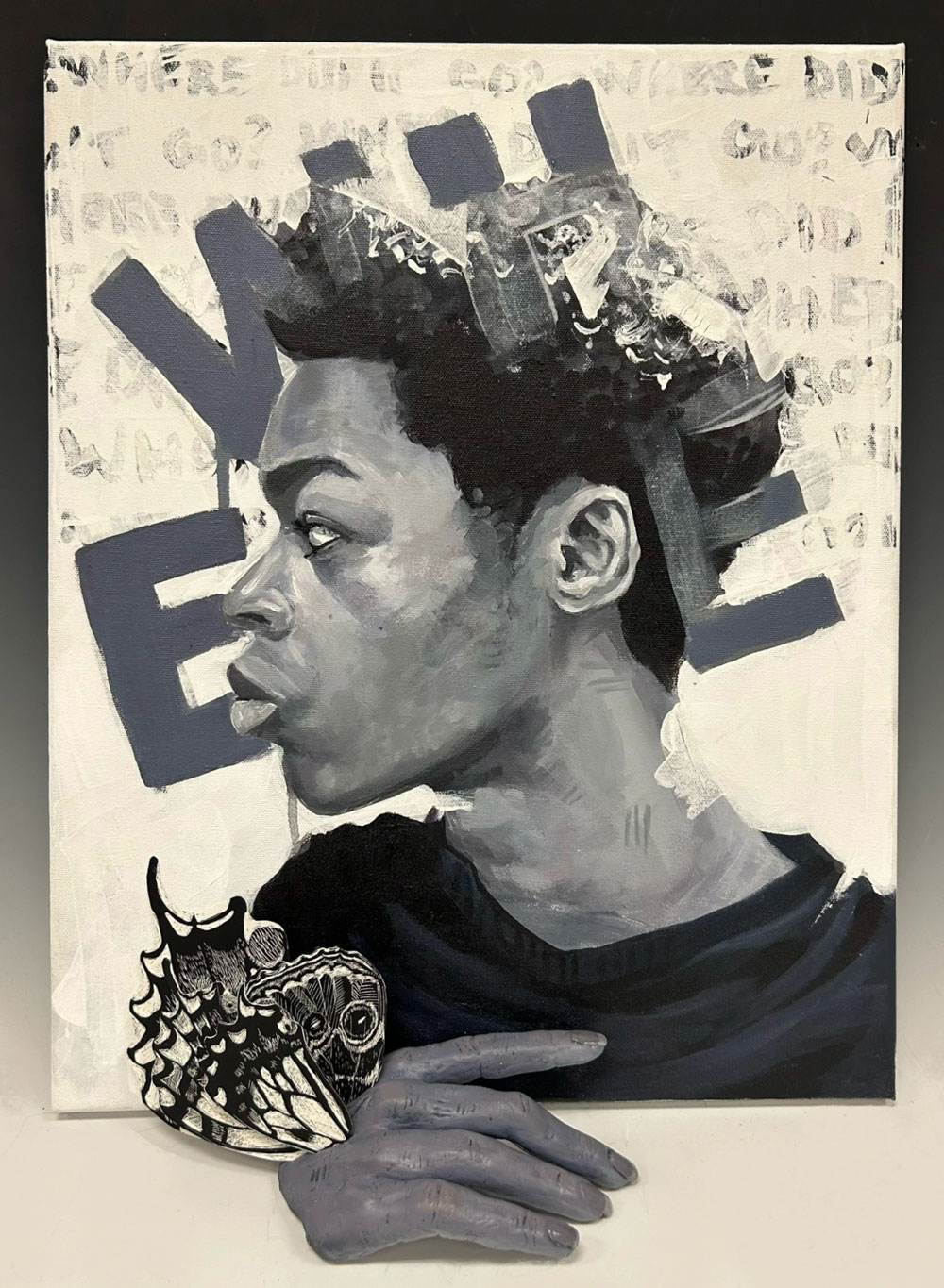
The Genius

Height: 20" x Width: 16" x Depth: 0.5" | Material(s): Acrylic paint, scratchboard, air-dry clay. | Process(es): Layered acrylic paint for portrait and text, sculpted hand, layered butterfly wings on scratchboard | Citation(s): Referenced butterfly-conservation.org for butterfly images. Referenced my side profile from selfie. | Idea(s): "WHERE DID THE GENIUS GO?" How can I always create a new/original piece? I can't, and that's okay. | Curatorial Note: Interesting combination of sculpture and painting.
Avery Watson
Student statement
Student statement
How did you demonstrate revision in your sustained investigation?
We were told to make sketches and layouts for each of our upcoming projects. My sketches were always digital—this one included—however, I made no sketch for this project. Leaving only the question of “WHERE DID THE GENIUS GO?” left a lot to be desired. I wasn’t confined to what I was able to create and add to a simple canvas. I had plenty of ideas that didn’t make the final cut, but that I wish I had had more time to add and experiment with. This is kind of where I think I failed in the meaning of my piece. This was a moment to truly show genius and raw, unbridled potential, but I was too scared to make a mistake and ruin my piece. Even though the finished product isn’t as experimental as I liked, I did let go of some parts of my perfectionism by covering the background letters, letting the “WHERE” interact with my head, and overlapping the background with my portrait. I still wish I was more experimental with what I added to the piece—but at the same time I feel proud of the piece as it is.

As my portfolio ended, I concluded that transformation and change doesn't just happen to you; you must choose it.
Please describe the context for how the idea for this artwork originated (was this part of your sustained investigation, an independent project, a class assignment, created during a summer study, etc.).
My sustained investigation was centered around transformation, change, and most importantly personal growth. I wanted to explore how I have changed as a person, who I am as a person, and who I am as an artist especially. This artwork is the perfect summation of all three of these inquiries. I had ideas for future projects, but I didn’t have a concrete idea for how I wanted this specific piece to turn out—in fact I didn’t actually know what this piece was going to be. So, for my digital sketch, there’s nothing here. It is quite literally a black page with white, diagonal letters receding into the distance; it simply asks the question, “WHERE DID THE GENIUS GO?????” A sort of double entendre as "GENIUS" could refer to the person (a genius) or the idea of genius (intelligence/creativity). This is a question I’ve asked myself for a while, because I always had this idea that when I was younger, I was a genius. When I was younger, I did not have all the resources, materials, and art supplies I have today, but I was able to use what little I had to make incredibly creative things. I used to make these paper animals—not like origami—similar to stuffed animals, but filled with paper. Now, obviously they weren’t realistic, but you could tell which animals they were, and I think they were pretty good for my age. I also think about how I was able to skip second grade (but I didn’t) purely because of how easily and quickly I grasped concepts—not to say that I can’t anymore. But I think it’s ironic that I eventually did skip my sophomore year of high school, but it had nothing to do with my intelligence. I simply took two summer classes.
I often ponder on whether I think the technology in my life has done me more harm or good artwise. On one hand, the internet (especially YouTube) has made me branch out into different media and styles that I may never have tried. I’ve gotten into crocheting, sewing, using foam clay, oil pastels, and so much more. But on the other hand, I feel as though getting my first personal device in sixth grade created a space for envy of others’ talents and dissatisfaction with my own. That space had never been present before because I had never had anyone’s art to compare my own to. Regardless, the point of the piece is to convey these recurring, repetitive thoughts that I pressure myself with every time I create a piece. With every artwork I make, I feel the need to make something never-before-seen—to reinvent the wheel. I think this piece sums up who I think I am as an artist and a person.
How did your materials and process(es) choices shape the creation or meaning of your artwork(s)?
I had had the idea to merge sculpture and 2D art for a while, and I thought this piece would be the perfect first trial. Originally, I wanted the clay to be stuck to the canvas with part of the hand being painted and the other part being sculpted. The hand was supposed to be more of a relief sculpture than an in-the-round sculpture. However, even with the aluminum foil armature, the hand was too heavy, and the air-dry clay I used did not stick to the canvas like I thought it would. Regardless, I made the hand and added slits in it. From there, I scratched out multiple butterfly wing designs on scratchboard. The butterflies are a repeated motif throughout my portfolio for their ties to transformation through metamorphosis. The wings sprouting from the hand is symbolic in how it represents a change in my creativity, skill, and genius. I had wings that were made of paper and had cutouts in them—these were meant to be added to the ears, but they got scrapped in the revision process.
How did your art teacher support your artistic development?
My AP Art teacher, Mr. Vigardt, was such a wonderful mentor. He had many ideas on how to expand upon what I wanted to do. He often encouraged me to go for ideas, materials, and processes that weren’t safe—in the sense that they pushed me to achieve and strive for something greater. And he would always be ready and willing to help me go the extra mile, which, in turn, allowed me to expand my horizons in different media. Something that was really important and special to me was how much Mr. Vigardt believed in me and my ability to create art—something I will be eternally grateful for.
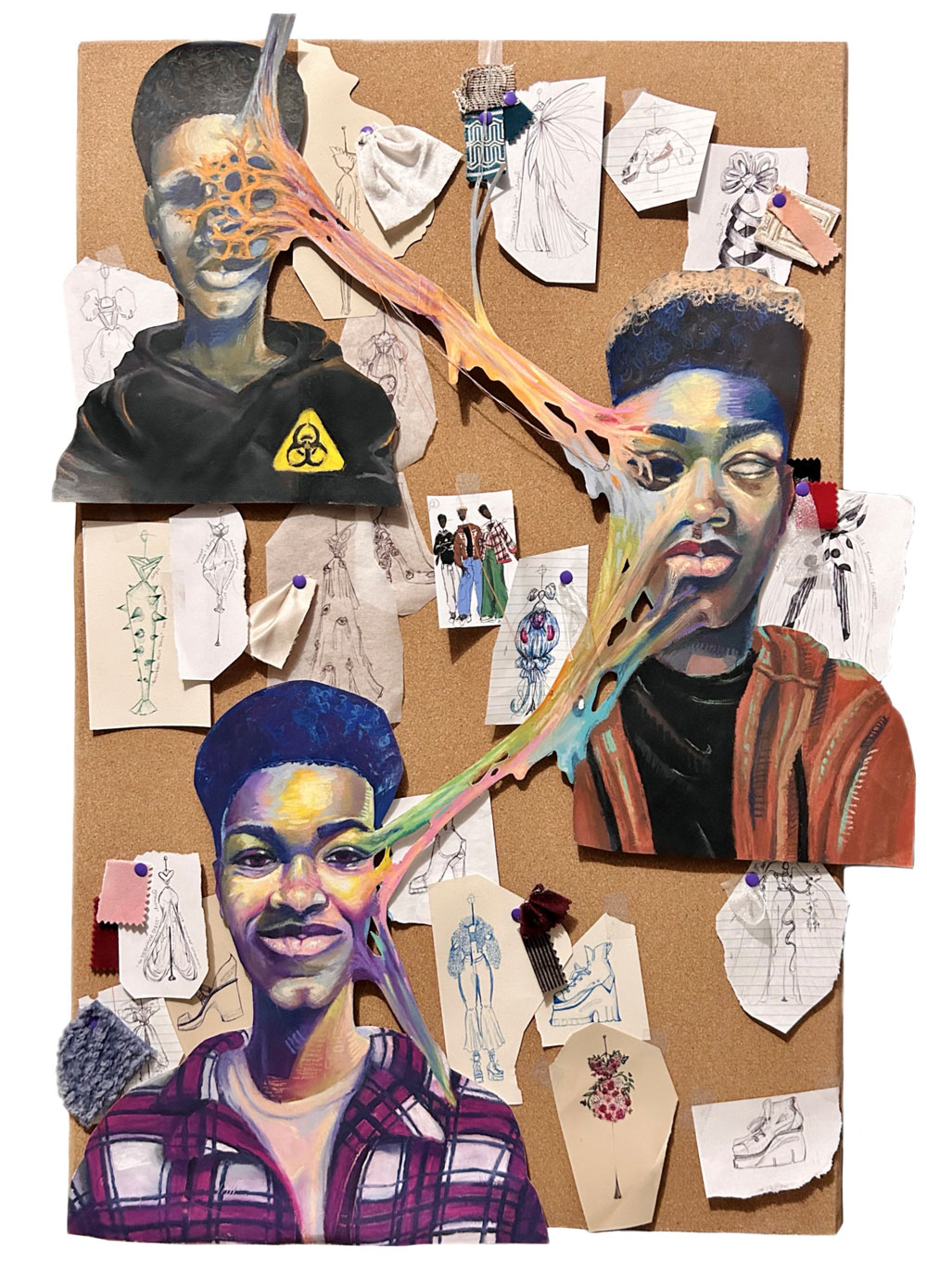
Avery, 2023 Summer Collection


Height: 36” x Width: 24” x Depth: 0.5” | Material(s): Cork board, oil pastel, pen/ink, fabric/textile, pushpins | Process(es): Created a temporary fashion vision board with rearrangeable parts to show changing ideas. | Citation(s): I referenced selfies from elementary, middle, and high school. I used my own fashion design sketches
What is your advice to other AP Art and Design students?
As much as it’s hard to do and easy to forget, this class does not have to feel like a chore. I feel like this piece of advice is often given and just as often ignored. If you don’t prioritize creating art that truly makes you happy, you shouldn’t expect to enjoy the class or the work you make. At the end of the first semester of AP Art, we were given a sheet to reflect on the things we could do better for the next semester. One thing I really wanted to do was focus on creating something that fit in with my sustained investigation, but more importantly make art that truly excited me. Previously, I had drawn a dragon with oil pastels and colored pencil for the first time, simply because I wanted to. And it brought me so much joy. All throughout the second semester, I was creating pieces that had me smiling and feeling proud throughout the entire process of creating them. Art felt like art again and not another class, not another deadline, just art. Make your process fun and make your art you. And don’t procrastinate.

Chris Vigardt
Visual Arts Teacher
Brookwood High School, Snellville, GA, USA
Teacher statement
Teacher statement
The AP Art and Design course supports inquiry-based personalized learning in the sustained investigation portfolio component.
What strategies helped you guide students through inquiry?
We spend a fair amount of time brainstorming at the beginning of the year using various strategies, such as brain dumps, word associations, mind maps, and funnel-down ideas using graphic organizers to land on one topic. From there, students are tasked with completing a sketchbook entry for each work of art, which includes a minimum of five different compositional ideas for each work, along with investigative questions that guide their thinking.
How did you scaffold writing into the art-making and thinking processes?
First semester, we focus on clarifying their topic and process through what inquiry is and how it can guide their thoughts. Moving into second semester, we write and rewrite their investigation statement at least five times. Each time students write, they participate in either a teacher editing process or peer editing process.
How did you support skill development AND inquiry in the AP Art and Design curriculum?
I am very active in the classroom, and since I have the course as a "stand-alone" class, I am able to address specific needs with skill through both informal and formal critiques. Also, students engage in peer critiques with all three portfolios, which allows students to leverage the strengths of their peers who speak into various skills by offering suggestions, examples, and insights.
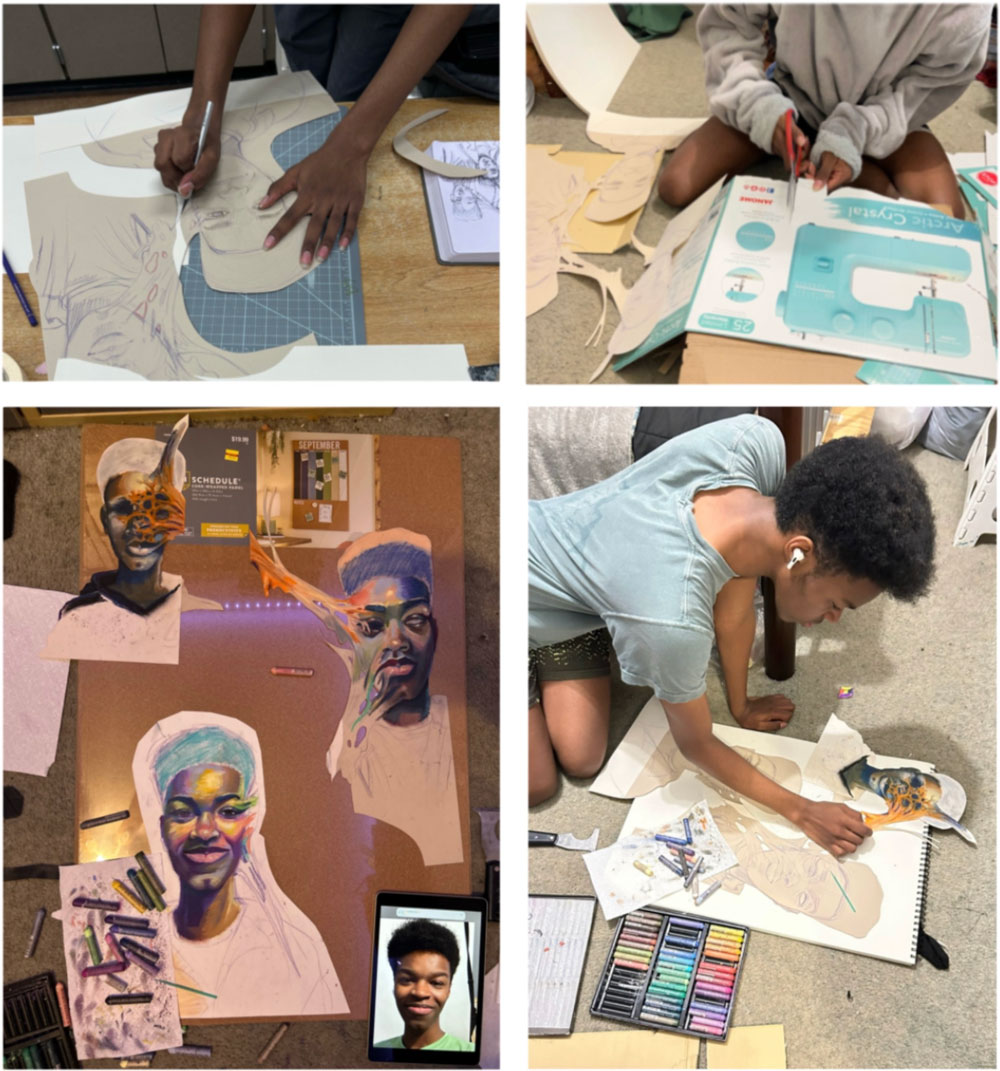
Height: 36" x Width: 24" x Depth: 0.5" | Material(s): Oil pastel, pen/ink, cork board, textile/fabric, pushpins. | Process(es): Cut out figures, colored with oil pastel. Cut out/redrew old fashion designs, added fabric samples. | Citation(s): I used my own sketches of dresses to add to the fashion board.
How did you structure practice, experimentation, and revision into your AP Art and Design curriculum?
I stress experimentation in the class and intentionally incorporate it into my grading rubric. Also, since the course is "stand-alone" students are able to see other possibilities from their peers during peer critiques. As for working practice, they are expected to work every day in class, and they are required to turn in "process" photos that document critical steps in their working practice. They turn in process photos midway through each project, and they are also required to create composite images later in the semester.
As for revision, I incorporate two weeks, one mid-semester with the other at the end of the semester for a "resubmission" week in which students are encouraged to adapt, change, alter, tweak, fix, and revise their works and resubmit them for assessment.
How do you support your students in the Selected Works portfolio component?
The primary objective in the class is the sustained investigation, from which students typically identify their BEST five works and use that for their "selected works." However, all our art students are required to take two-year-long art classes before AP Art and Design, and we see this as our pre-AP program. Students are welcome to select works from those years if they are visually stronger in idea and skill.
What formative and summative assessments helped guide your students through your AP Art and Design curriculum?
Formative assessments are sketchbook entries, brainstorming activities, and process documentation, where summative assessments are the actual artworks students complete and turn in. I plan out all due dates at the beginning of the school year and pace students through their portfolio.
What creative programming (i.e., exhibit spaces, mentoring programs, curricular supports) have you implemented to support AP Art and Design students?
We showcase AP artwork through local, regional, and national contents/exhibits. We also offer Open Studio sessions after school on a weekly basis. Additionally, we emphasize immediate and critical feedback through personal conversations.
What did you learn from working with your student?
I learned to allow students to work traditionally or digitally for their sketchbooks and artwork. It is OK for them to embrace various media and plans of action for their work. We live in a day and age where there are more tools, materials, and experiences available to students than ever before. So I try to not limit students’ ideas and rather help encourage broad, creative endeavors while providing specific feedback to guide them towards completing a work of art. So, celebrate diverse media and ideas.
Is there anything your school leadership does to support your art students or the art program?
Yes, our leadership provides the funding for materials and tools necessary for students to be successful. Having access to a variety of materials/tools is an asset, along with encouragement through highlighting student artwork via social media.
What is your advice to other AP Art and Design teachers?
Twofold, first I would strongly recommend working with your local school to create a "stand-alone" AP art and design course, as opposed to embedding AP Art students into other courses. These students are often more invested and focused than other students who are simply taking an art class because "they like it," and the creative atmosphere that is generated when they are together in one space allows for strong peer collaboration, informal and formal peer critiques with students who have similar attributes, along with benefitting from others who work with different media, which speaks to and encourages experimentation. Not to mention it is less stressful than dividing a teacher’s attention between various preps in one class period.
Second, foster, encourage, and expect experimentation with media and ideas. This should be a safe space where students are afforded the time and ability to explore before the world outside of the classroom asks them to focus on singular ideas or materials. Encourage the "what if's." The hypotheticals should be the norm.

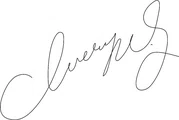
Avery Watson

